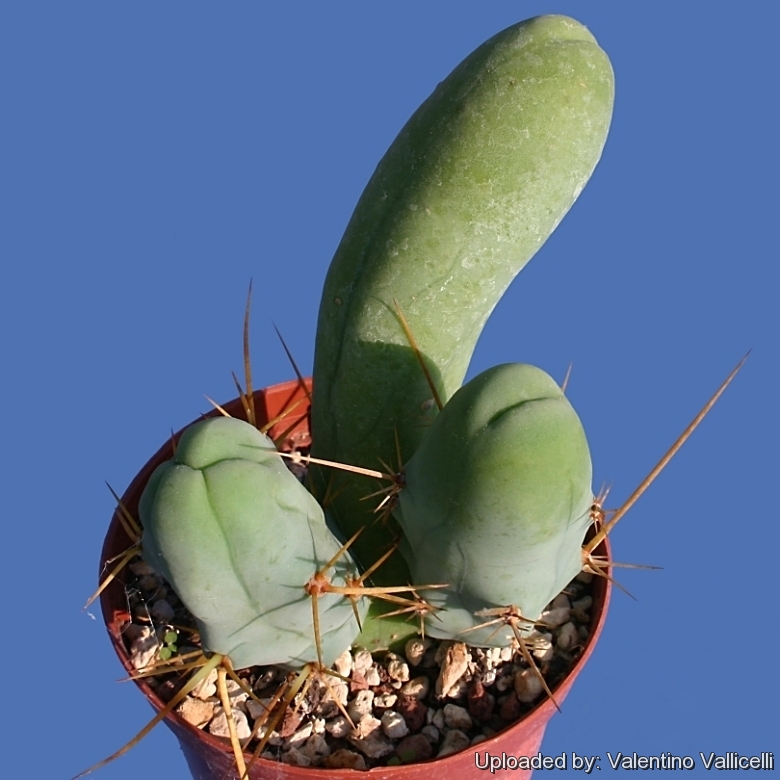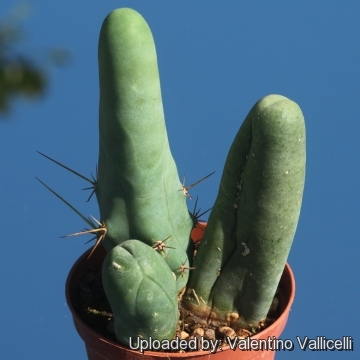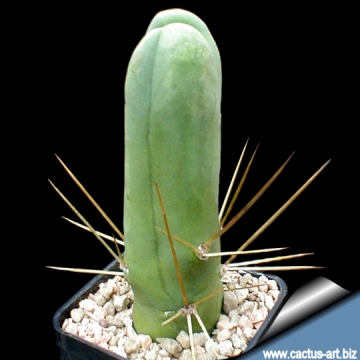Accepted Scientific Name: Echinopsis lageniformis f. monstruosa (Long joined type)
(= inermis) a.k.a. "Penis Cactus"

Echinopsis lageniformis cv. Penis Cactus (Echinopsis lageniformis f. monstruosa (Long joined type)) Photo by: Valentino Vallicelli
It is often known by the name "Penis Plant", it is much slower growing than the standard form of the species, but owing to its highly unusual shape, it is sought after by cactus impassioned.
Origin and Habitat: Garden origin (Nursery produced cultivar)
Synonyms:
See all synonyms of Echinopsis lageniformis
Common Names include:
ENGLISH: Penis Cactus, The More Sensual of Cacti, San Pedro Penis, Pornographic Cactus, Penis plant
GERMAN (Deutsch): Frauenglück
ITALIAN (Italiano): Cactus Pene, Cazzone
PERSIAN (فارسی): اکینوپسیس لاگنیفورمیس
Description: This is the long jointed clone, one of the two Montrose form o T.bridgesii It is a clustering monstrous cactus with prostrate growth habit that branches at the base and can slowly grow up to 40(-60) cm tall.
Stem: Composed by short upright sections that branches avidly up to 10-20 (-35) cm tall by 5 cm in diameter, light glaucous green, with only a few areoles and spines in the basal portion. The upper part of the stem is cylindrical, smooth without areoles and resemble a penis. The lower part is spiny and shows a tendency to form ribs.
Spines:Honey-coloured to brown, located on the few basal nodes in groups of up to 4. They can grow up to 4–7 cm long.
Flowers: Not known.
NOTE 1: There exist several mutant varieties of this T. bridgesii that are highly prized by cactus impassioned. These include a cristate variety, a variegated variety and two variants of monstrose growth. Of the monstrose varieties, one is often known by the name Penis Plant.
Two more recently developed clones are now available, the fist of which exhibits both monstrose and cristate growth whilst the second shows both monstrose and variegated growth.
NOTE 2: The chemical composition of the 'Penis Plant' is supposedly the same as that of the typical T.bridgesii.
More...Subspecies, varieties, forms and cultivars of plants belonging to the Echinopsis bridgesii group
Notes: The plant contains a number of psychoactive alkaloids, in particular the well-studied chemical mescaline, which it may contain at levels higher than those of the San Pedro cactus. Chemical analysis of some variants of this species have shown it may include some of the most potent of the psychedelic Trichocereus species, although this is not conclusive nor does it apply to all strains of the species. Outside of its native habitat, it is one of the least known and used of the Trichocereus cacti for either its psychoactive or ornamental uses. This is not true in areas where it is the dominant species, for example, the La Paz area of Bolivia. As with related species, it seems to have long shamanic tradition of use throughout its native habitat.
Bibliography: Major references and further lectures
1) N. L. Britton, J. N. Rose: “The Cactaceae. Descriptions and Illustrations of Plants of the Cactus Family.” Vol I, The Carnegie Institution of Washington, Washington 1919
2) Edward Anderson “The Cactus family” Timber Press, Incorporated, 2001
3) James Cullen, Sabina G. Knees, H. Suzanne Cubey "The European Garden Flora Flowering Plants: A Manual for the Identification of Plants Cultivated in Europe, Both Out-of-Doors and Under Glass" Cambridge University Press, 11/Aug/2011
4) David R Hunt; Nigel P Taylor; Graham Charles; International Cactaceae Systematics Group. "The New Cactus Lexicon" dh books, 2006
5) Curt Backeberg “Die Cactaceae: Handbuch der Kakteenkunde,” Volume 2 G. Fischer, 1959
6) Urs Eggli, Leonard E. Newton “Etymological Dictionary of Succulent Plant Names.” Springer, Berlin/Heidelberg 2010
7) Gordon Douglas Rowley “Reunion of the genus Echinopsis.” In: IOS Bulletin. Journal of the International Organization for Succulent Plant Study. 3(3): 98, 1974.
8) Lowry, M. 2013. Echinopsis lageniformis. The IUCN Red List of Threatened Species. Version 2014.3. <www.iucnredlist.org>. Downloaded on 02 May 2015.
9) Wikipedia contributors. "Echinopsis lageniformis." Wikipedia, The Free Encyclopedia. Wikipedia, The Free Encyclopedia, 26 Mar. 2015. Web. 2 May. 2015.
10) Madsen, Jens. "5. Echinopsis Zucc.". Flora of Ecuador (Gunnar Harling & Lennart Andersson) (35): 27–30.A
11) Herrero-Ducloux, Enrique. "Datos quimicos sobre el Echinopsis eyriesii". Revista de la Facultad de Ciencias Quimicas Universidad Nacional de La Plata (in Spanish) 2 (6): 43–49.
12) "Cactacae - Sacred Succulents". Sacred Succulents. <http://sacredsucculents.com/cactaceae/> Web. 2 May. 2015.
More... Echinopsis lageniformis cv. Penis Cactus (Echinopsis lageniformis f. monstruosa (Long joined type)) Photo by: Cactus Art
Echinopsis lageniformis cv. Penis Cactus (Echinopsis lageniformis f. monstruosa (Long joined type)) Photo by: Cactus Art trichocereus bridgesii f.mostruosa at Giardini Ravino (Ischia), Italy. (Echinopsis lageniformis f. monstruosa (Long joined type)) Photo by: Flavio Agrosi
trichocereus bridgesii f.mostruosa at Giardini Ravino (Ischia), Italy. (Echinopsis lageniformis f. monstruosa (Long joined type)) Photo by: Flavio Agrosi Echinopsis lageniformis cv. Penis Cactus (Echinopsis lageniformis f. monstruosa (Long joined type)) Photo by: Cactus Art
Echinopsis lageniformis cv. Penis Cactus (Echinopsis lageniformis f. monstruosa (Long joined type)) Photo by: Cactus Art Echinopsis lageniformis cv. Penis Cactus (Echinopsis lageniformis f. monstruosa (Long joined type)) Photo by: Valentino Vallicelli
Echinopsis lageniformis cv. Penis Cactus (Echinopsis lageniformis f. monstruosa (Long joined type)) Photo by: Valentino Vallicelli Echinopsis lageniformis cv. Penis Cactus (Echinopsis lageniformis f. monstruosa (Long joined type)) Photo by: Valentino Vallicelli
Echinopsis lageniformis cv. Penis Cactus (Echinopsis lageniformis f. monstruosa (Long joined type)) Photo by: Valentino Vallicelli Echinopsis lageniformis cv. Penis Cactus (Echinopsis lageniformis f. monstruosa (Long joined type)) Photo by: Cactus Art
Echinopsis lageniformis cv. Penis Cactus (Echinopsis lageniformis f. monstruosa (Long joined type)) Photo by: Cactus ArtCultivation and Propagation: Itis very easy to grow and cold hardy as low as -12°C (or less). Need a fertile, well drained soil mix. Water the plants well and allow them to dry before watering again. This cultivar seems to do better with a little more water than most cacti. In fact, its cultivation requirements are really more like 'normal' plants than most other cacti. During the growing season fertilize them monthly with a balanced fertilizer
Sun Exposure: Outside full sun, but during hot summers, the cactus are subject to sun burning, so grow them in light shade, inside needs bright light, and some direct sun.. During winter month, put them in a cool luminous place and encourage them to enter winter dormancy by withholding water and fertiliser over the winter as they will etiolate, or become thin, due to lower levels of light. They are susceptible to fungal diseases if overwatered, but are not nearly as sensitive as many other cacti, especially in warm weather. They tend characteristically towards black rotted spots unless watering is moderate and only in hot weather, if kept damp through cold periods, they will invariably suffer.
Propagation: It can easily be multiplied from cutting. Single sections are taken off, dried and rooted.
More...
















